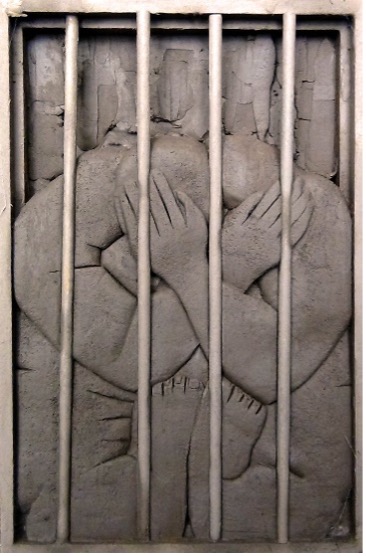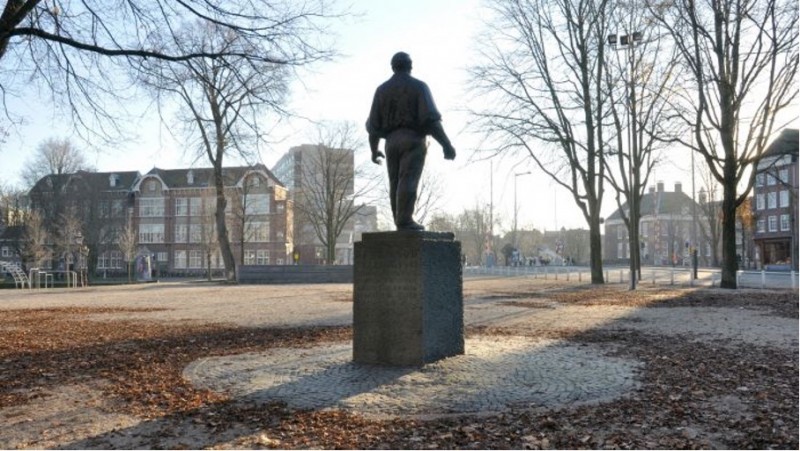As part of the commemoration of 80 years of Freedom in the Netherlands, Beelden aan Zee Museum will present an installation in 2025 titled Voici mon cœur ! (Here is my heart) by Syrian artist Khaled Dawwa (Maysaf, 1985). The six-meter-long, impressive contemporary war monument takes the form of a ruined façade wall from a violence-stricken Damascus. Dawwa fled Syria with his family due to the civil war, which lasted until the end of 2024.
By presenting this work within the context of 80 Years of Freedom in the Netherlands, the Beelden aan Zee museum invites visitors to reflect on the lasting consequences of war and oppression, not only in the context of World War II but also in relation to contemporary conflicts. As we mark the 80th anniversary of the liberation of the Netherlands in 2025, Dawwa's work provides a contemporary perspective on freedom and unfreedom. The artwork reminds us that the struggle for freedom and human dignity does not end with a date but is an ongoing process.
For more information about the war in Syria, please visit:
bbc.com/news/world-middle-east-35806229
About Voici mon Cœur !
Dawwa created the work Voici mon Cœur ! in his studio in Paris between 2018 and 2022. The bullet-riddled façade, which looks like it could collapse at any moment, is Dawwa’s way of expressing his situation as an artist in exile. It represents his longing to return home, the depiction of loss, an experience of emptiness, and the disastrous situation in Syria.
The model depicts a fictional place, but it evokes real neighborhoods in Damascus. Dawwa speaks of his work as a self-portrait, a glimpse into his own memory. Everyone who might want to embrace or meet Dawwa is given a place through the objects, spaces, and everyday items carelessly left behind.
About Khaled Dawwa
Khaled Dawwa was trained at the Academy of Fine Arts in Damascus, where he graduated in 2007. He was forced to leave Syria due to the war that began in 2011 and ended in late 2024 with Assad’s departure. As a result of the civil war, Dawwa had to flee to Lebanon, where he stayed for a year. He then moved on to France, as it was also impossible to build a life in Lebanon. In 2014, he was able to set up a studio in Vanves, just outside Paris, where he continues to work to this day.
About his work
A recurring theme in his work is the corpulent figure, chained to his chair, with a fully perforated or porous exterior. This creates a contradictory effect: the man in his chair appears to be an immovable monolith, yet his outer layer is riddled with holes, not solid. Dawwa sometimes inflates these kinds of men to monumental proportions. One can interpret this as a commentary on the nature of power: the ruler projects the image of being a rock, an unshakable force of nature, but when you come closer, you see the erosion of his damaged exterior.
His groups of corpulent figures, demonstrating together (And We Chanted for Freedom, 2011–14), or lying together—exhausted or dying—among oil barrels, are even more politically charged. The bodies are not idealized. The people are collectively exhausted, or trying to resist, but those other old, overweight men in their armchairs—the ones in power—do not move.

Khaled Dawwa - And We Chanted for Freedom (2011-2014)
Stylized figures, almost drawn into the clay, in relief and trapped within a square shape or a cell, are titled Get me Compressed (2015).
The sense of confinement is physically tangible, just as it is in the seated figures wrapped in ropes in Liberté (2019).


Khaled Dawwa - Get me compressed (2015), Khaled Dawwa - Liberté (2019)
Khaled Dawwa created artworks in both Syria and Lebanon. However, due to his forced flight, he had to destroy many of his pieces—either for safety reasons or simply because there was no way to store them. He did, however, document all the works that were destroyed and published them on a dedicated Facebook page: https://www.facebook.com/share/15fJ6dg7Eq/
A Contemporary War Monument
The rise of war monuments after the Second World War played a significant role in the development of Dutch sculpture. They legitimized the presence of sculpture in public space—a form of art that, until then, had no strong tradition in the Netherlands. Thanks to the large number of commissions for war memorials, the Netherlands emerged after the war as a country with its own distinct sculptural tradition.

De Dokwerker in Amsterdam, a well-known war monument in the Netherlands by Mari Andriessen.
The work Voici mon coeur ! by Khaled Dawwa offers an innovative and contemporary interpretation of the tradition of war memorials. While traditional Dutch war monuments often commemorate specific events or victims from World War II, usually depicted in human figures, Dawwa's work focuses on a more recent conflict—the Syrian Civil War.
This brings the tradition of war remembrance into a contemporary context, reflecting modern experiences in the form of architecture, a model, and a cabinet in which the lives of the inhabitants are expressed through objects and furnishings. This approach is reminiscent of Georges Perec’s famous Life: A User’s Manual (1978), where the lives of the residents in a Parisian apartment building are described through detailed depictions of their objects and the furnishings of their apartments—without ever having the characters themselves appear in the text.
For a detailed explanation, see: http://escarbille.free.fr/vme/ en https://en.wikipedia.org/wiki/Life:_A_User%27s_Manual
A personal interpretation
In contrast to the collective memory represented by many traditional monuments, Voici mon coeur ! offers a very personal, emotional interpretation of war and exile, directly stemming from Dawwa's own experiences. The abstract form of the work deviates from the often figurative representations in war monuments and leaves room for individual interpretation. While inspired by a specific conflict, the work touches on universal themes of loss, identity, and the search for freedom, making it resonate with a broad audience.
Like traditional war monuments, Voici mon coeur ! also fulfills an educational function, serving as a tool to raise awareness and stimulate dialogue about the impact of war and the importance of freedom. By placing Voici mon coeur ! in the context of war monuments, a bridge is built between the past and the present. It invites reflection on the lasting relevance of themes such as war, freedom, and identity in our current society. The work enriches the tradition of war monuments by adding a contemporary perspective and demonstrating how many sacrifices are still made every day in the fight for freedom, worldwide.
Points of overlap
Model in architecture
An architectural model is a representation of a future building, district, or city. To get a grasp of the spatial situation in broad terms, the model is indispensable. However, in our era, a digital model is becoming increasingly important. Still, the physical model remains a useful tool to convince clients.
Cabinet of curiosities
A cabinet of curiosities is a collection of rarities that together offer an image of the complexity of the world in the broadest sense of the term. This could include coral, scientific instruments, prints of old cities, taxidermied animals, dried flowers, fossils, minerals—essentially a sample of scientific and artistic disciplines. In the seventeenth and eighteenth centuries, the collector expanded the cabinet into a room, perhaps even an entire building. The Teylers Museum in Haarlem is an example of such a large collection of curiosities.
Dollhouse
Miniature houses have been known since ancient Egypt, but as toys, they became fashionable starting from the sixteenth century. Attractive houses, designed to invite both looking and touching. Madurodam, located in Scheveningen, is an expanded version of the dollhouse and the architectural model.
Model in architecture
An architectural model is a representation of a future building, district, or city. To get a grasp of the spatial situation in broad terms, the model is indispensable. However, in our era, a digital model is becoming increasingly important. Still, the physical model remains a useful tool to convince clients.